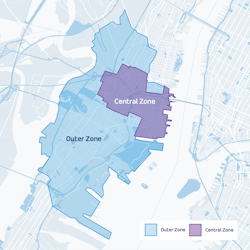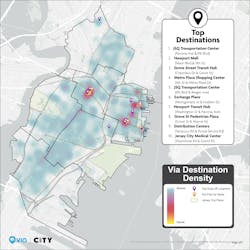Jersey City’s on-demand transit success story
In September 2019, the municipal leaders of Jersey City, N.J., frustrated by overcrowded buses and unreliable schedules of its regional transit provider, announced a first for the state: a municipal-subsidized, on-demand rideshare network.
The city does not hesitate when it calls the service, Via Jersey City, a success. It has complemented and extended existing transit infrastructure, broken ridership records and exceeded the city’s goals, including closure of transit gaps to those areas where transit is needed most.
Riders use the Via app or, for those riders without a smartphone, call a dedicated phone line to select a pickup and drop-off location within the service zone. Fares are $2 per ride.
“Via is one of many examples of how we are addressing the most stubborn of issues that urban areas traditionally face by taking an outside-the-box approach to overcome these difficulties and improve quality of life for our community,” said Jersey City Mayor Steven M. Fulop.
The increasing demand for the service meant the Via fleet was expanded from 17 to 26 vehicles in the third quarter. The fleet consists of 24 Mercedes Metris vans and two Kia Niro electric cars. Due to the ongoing need to maintain physical distance of riders, capacity of vehicles is limited.
“Despite launching right as the pandemic struck, Via Jersey City is breaking ridership records and connecting the exact communities we targeted with more affordable service to close transit gaps, increased access to jobs and education, improved connectivity, among countless other opportunities. The data shows our low income and diverse populations are benefiting most,” said Mayor Fulop.
A rider survey conducted in November found more than half of the service’s riders identified their annual household income as at or below $50,000 with more than 27 percent identifying their annual household income under $25,000.
“The initial survey results speak to the success of Via JC in serving the people who have historically been underserved by transit. We are committed to improving mobility in Jersey City by making it easy for residents to use more efficient and sustainable modes of transportation like Via,” said Jersey City Director of Transportation Planning Barkha Patel.
“We partnered with Via to expand and improve transportation options throughout the city, with a focus on neighborhoods that had inadequate service. Via JC continues to meet and exceed our ridership, efficiency and quality of service goals,” said Brian Platt, former Jersey City business administrator.
While the service has exceeded mobility goals, the partnership between Jersey City and Via extends to ensure food security. The city says it experienced a 300-percent increase in demand for Meals on Wheels during the pandemic and Via drivers were recruited to deliver food.
When the partnership between Jersey City and Via was originally announced, Mayor Fulop explained the on-demand service fit into the city’s larger vision of reducing car traffic on local roads. Via’s third quarter environmental performance report says the service has saved an estimated 2,452 gallons of gasoline during the quarter, more than 48,000 pounds of carbon dioxide and 53,946 miles.
"Mayor Fulop and his team have set an example for municipalities across the country as they take on unprecedented social and economic challenges and work tirelessly to improve quality of life for those with the greatest need," said Daniel Ramot, CEO and co-founder of Via. "This starts with providing accessible and equitable public transportation, and we are proud to see the clear, positive impact that on-demand public transit, powered by Via's technology, is having on the community in Jersey City."
About the Author

Mischa Wanek-Libman
Group Editorial Director
Mischa Wanek-Libman is director of communications with Transdev North America. She has more than 20 years of experience working in the transportation industry covering construction projects, engineering challenges, transit and rail operations and best practices.
Wanek-Libman has held top editorial positions at freight rail and public transportation business-to-business publications including as editor-in-chief and editorial director of Mass Transit from 2018-2024. She has been recognized for editorial excellence through her individual work, as well as for collaborative content.
She is an active member of the American Public Transportation Association's Marketing and Communications Committee and served 14 years as a Board Observer on the National Railroad Construction and Maintenance Association (NRC) Board of Directors.
She is a graduate of Drake University in Des Moines, Iowa, where she earned a Bachelor of Arts degree in Journalism and Mass Communication.


